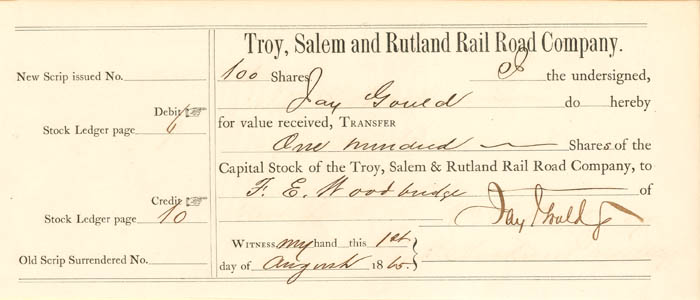Troy, Salem and Rutland Rail Road Co. signed by Jay Gould - 1865 dated Transfer Receipt
Inv# AG1815
Vermont
Stock signed by Jay Gould. Very Rare! Portrait and biography included.

Jason “Jay” Gould (1836-1892) was born in Roxbury, N. Y., the son of John Burr Gould and Mary Moore Gould. He studied at the Hobart Academy, but left at age 16 to work for his father in the hardware business. He continued to devote himself to private study, emphasizing surveying and mathematics. Gould later went to work in the lumber and tanning business in western N. Y. and then became involved with banking in Stroudsburg, PA. In 1856 he published the History of Delaware County. He married Helen Day Miller in 1863 and had 6 children.
It was during the same period that Gould and James Fisk became involved with Tammany Hall. They made Boss Tweed a director of the Erie RR., and Tweed, in return, arranged favorable legislation for them. Tweed and Gould became the subjects of political cartoons by Thomas Nast in 1869. In 1871 when Tweed was held on $8 million bail, Gould was the chief bondsman.
In August 1869, Gould and Fisk began to buy gold in an attempt to corner the market. During this time, Gould used contacts with President Ulysses S. Grant's brother-in-law to try to influence the president and his Secretary General. These speculations in gold culminated in the panic of Black Friday, on September 24, 1869, when the premium over face value on a gold Double Eagle fell from 62% to 35%. Gould made a nominal profit from this operation, but lost it in the subsequent lawsuits. The affair also cost him his reputation.
After being forced out of the Erie Railroad, in 1879 he started to build up a system of railroads in the Midwest by gaining control of four western railroads, including the Union Pacific and Missouri Pacific. In 1880, he was in control of 10,000 miles of railway and by 1882 he had controlling interest in 15% of the country's tracks. Gould withdrew from management of the UP in 1883 amidst political controversy over its debts to the federal government, realizing a large profit for himself. Gould also obtained a controlling interest in the Western Union telegraph company, and in the elevated railways in New York City. He was connected with many of the largest railway financial operations in the U. S. from 1868-1888. During the Great Southwest Railroad Strike of 1886 he hired strikebreakers; according to labor unionists, he said at the time, "I can hire one half of the working class to kill the other half."
In his lifetime and for a century after, Gould had a firm reputation as the most unscrupulous of the 19th century American businessmen known as robber barons. Read more at https://en.wikipedia.org/wiki/Jay_Gould
The Rutland and Washington Railroad was a railroad company based in Rutland, Vermont which was chartered in Vermont on November 13, 1847, and built between Rutland and Eagle Bridge in Rensselaer County, New York in 1851 and 1852. One of the company's founders was Merritt Clark, a Vermont politician, and another was Thomas Canfield, later involved with the Northern Pacific. In order to build in New York, the company, on June 24, 1850, took a perpetual rent-free lease of the franchise rights east of Salem of the Troy and Rutland Railroad, which had been chartered in that state on July 2, 1849. The remainder of the Troy and Rutland, from Salem west to Eagle Bridge, was completed in 1852 and leased to the Rutland and Washington effective July 2. After the Panic of 1857, a majority of the company's bonds were acquired by Jay Gould at 10 cents on the dollar, which left him in control of the company. Gould is identified as the company's superintendent in a July 1863 newspaper article.
The company's property (Salem to Rutland) was sold at foreclosure in 1865, the portions in New York and Vermont being sold on March 15 and May 23, respectively, to holders of the Rutland and Washington's securities. The property of the Troy and Rutland (Eagle Bridge to Salem) was sold on July 11, 1863, to Jay Gould. The property in New York was conveyed to the Troy, Salem and Rutland Railroad (incorporated June 3, 1865) on June 3 (Eagle Bridge to Salem) and June 30 (Salem to state line). On February 1, 1867, the Salem and Rutland Railroad was incorporated and received the portion in Vermont. The Troy, Salem and Rutland leased the Salem and Rutland on March 19, and subsequently acquired its entire stock, allowing the latter to release the former from all obligations on October 10, 1867. However, the Troy, Salem and Rutland was never an operating company, immediately leasing its road to the Rensselaer and Saratoga Railroad upon acquisition until it was merged into that company on October 20, 1868. The Delaware and Hudson Canal Company leased the Rensselaer and Saratoga, including the Eagle Bridge-Rutland line, on February 24, 1870. Read more at https://en.wikipedia.org/wiki/Rutland_and_Washington_Railroad










Ebay ID: labarre_galleries